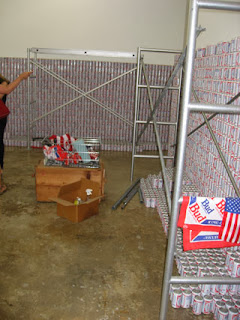"Influence" and the weight of the past
Cady Noland, “This Piece Has No Title Yet” (1989), at the Rubell Family Collection, Miami
I am a big fan of the on-line art blog Hyperallergic, which this morning surprised me with a very interesting article by Martha Buskirk about the artist Cady Noland, who like the French painter Simon Hantaï at the height of his career, secluded herself from the on-goings of the Art Market.
An image that struck me in the article was Noland's piece "This Piece Has No Title Yet" from 1989. Exactly, as Buskirk notes, because of the importance of its "influence" on current art practices. Let me explain.
One cannot live here in Paris without hearing every so often about the Berlin-based French video and installation artist Cyprien Gaillard, who won the Prix Marcel Duchamp back in 2010. His practice is based on the archaeology of monuments both old and new, or at least his interpretation of what archaeology is (as spectacle, as a mise-en-scène). Perhaps his most media-genic piece, the one that put him on the high society map (to be hip here in Paris, one adds to any discussion on contemporary art, "j'adore Cyprien Gaillard"), is this one:
Cyprien Gaillard, "The Recovery of Discovery," 2011, KW Institute of Contemporary Art, Berlin
In essence, a pyramidal "monument" of six-packs is placed inside the art gallery, and revelers are allowed to enjoy the booze through the event, to the point where the monument decomposes, at least its most accessible parts.
Gaillard gave an interview for his exhibition at the Centre Pompidou, in recognition of his winning the Prix Marcel Duchamp, a year ago, detailing the crux of his practice:
Je m'intéresse à l'archéologie pour son potentiel sculptural et en tant que pratique, avec l'idée que l'excavation, la découverte d'un site va souvent de pair avec sa destruction : plus on fouille, plus on détruit, et mieux vaudrait parfois tout laisser intact sous la terre. Se pose la question des choix de préservation - pourquoi protéger un site tandis qu'un autre est démoli par les pelleteuses ? Tout est archéologie dans une ville, tout est ruine.My translation:
I am interested in archaeology, in its sculptural potential and also as a practice, with the idea that the excavation, the discovery of a site will also lead to its destruction. The more one digs, the more will be destroyed, and sometimes it may be better to leave it all underground. The question of preservation comes up--why would one leave a site intact while another is demolished by backhoes? All is archaeology in a city, all is a ruin.
Reviewing the Berlin exhibition, Svea Jürgenson writes:
In the end, however, the “monumental dialectic” of obsession and neglect is not complicated for the benefit of the participator. Thus, what remains of the exhibition is the memory of a fascinating spectacle that might too easily be replaced by another sensational event.Why, I wonder, do I have doubts about this recycling of Cady Noland's concept of Budweiser cans against a gallery wall? After all, Gaillard has transformed the wall- (and floor-) lined beer can concept into a truly monumental sign of eternity, a beer pyramid. After all, Budweiser has been replaced by Efes, and after all, 22 years had gone by, from 1989 to 2011, well that is an eternity.
John Yau, again in Hyperallergic, wrote recently about the recycling of American Minimalism's surfaces and intent by contemporary artists of the 21st century, saying, about the work of Wade Guyton, amongst others, currently on view at the Guggenheim in New York:
If the imperfect copy or ironic shout-out helps verify the academic view dismissing the author and originality, it also reinforces the belief that art is all about style, the look of the thing.What happens when one recycles the concept of a concept?
I just finished reading an essay on the masters of Italian Mannerism of the 16th century by Patrick Mauriès.* He points out that the children of the High Renaissance, where "perfection" of harmony and style was attained by its greatest masters (Raphael and Michelangelo, in particular), the Mannerist painters were left with a repertoire of perfection, of the highest achievements in painting, and thus were confronted with an impossibly perfect precedent. Their way out? The modification and exaggeration of the stylistic conventions of their forebears' perfection.
Aucune rupture, aucune révolution, pas d'innovation profonde : obsédée par la richesse de l'invention, la manière n'est pas inventive ; elle se range plutôt du côté de la parodie, du mélange, privilégie le décalage, la dérive et les greffes de formules toutes trouvées.*My translation:
No breaking away, no revolution, no deep innovation. Obsessed by the rich inventions of the past, the Manner is not inventive; it aligns itself more on the side of parody, of blending, privileging discrepancy, the derivative, and the transplantation of easily found formulas.It is strange, but it appears to me that both John Yau and Patrick Mauriès appear to be using the same words to speak of two different sets of artists.
Michele Di Ridolfo Del Ghirlandaio, "Allegory of the Night", c.1553-1555, Galleria Colonna, Rome
No wonder then that when I saw the "Allegory of the Night" by the Italian Mannerist Michele Di Ridolfo Del Ghirlandaio recently at the Musée du Luxembourg, I thought it felt extremely "TODAY", its large "POP"art pristine porcelain body, its recycling of the past (Michelangelo's sculpture), its archaeology of idioms and its unending references, all embodied again in this big white milky skin, a perfectly eye-catching and media-ready excavation of style.
*Patrick Mauriès, Manieristes, Paris: Editions de la Lagune, 1995.
.







Comments
Post a Comment